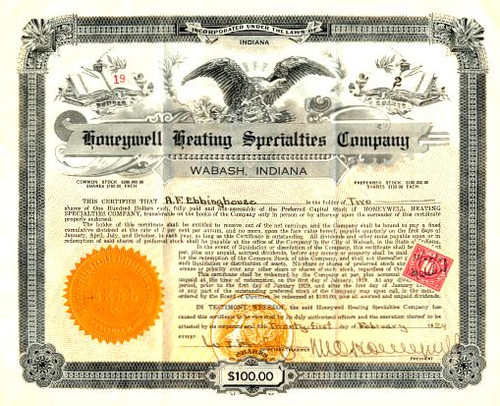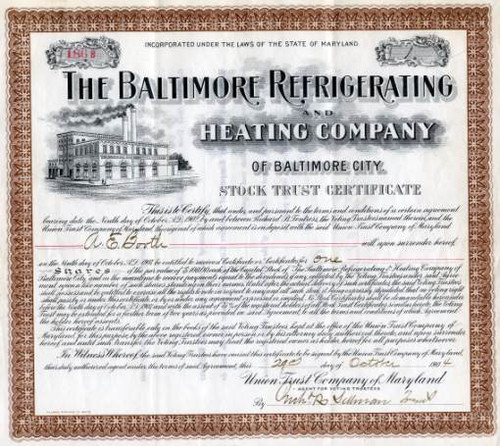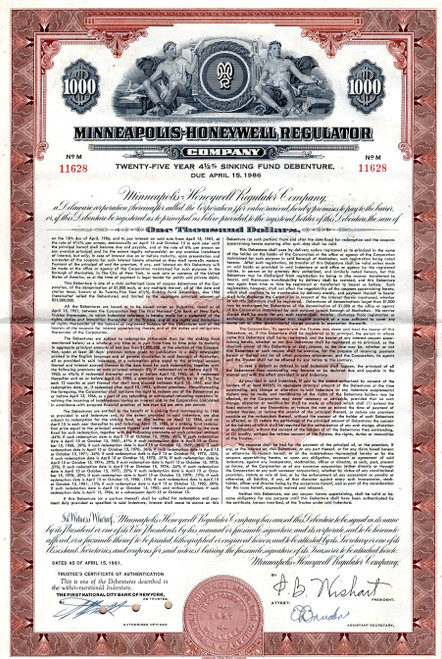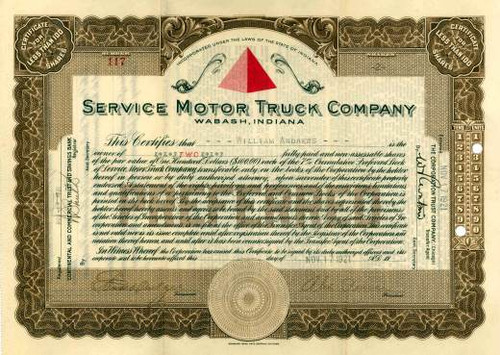Beautiful certificate from the Honeywell Heating Specialties Company issued in 1924. This historic document has an ornate border around it with a vignette of an eagle and an orange underprint of a dog on the bottom. There is also an embossed corporate seal. This item has the signatures of the Company's President, Mark C. Honeywell and Secretary, W. J. Huff and is over 90 years old. This company's stock certificate is quite scarce. 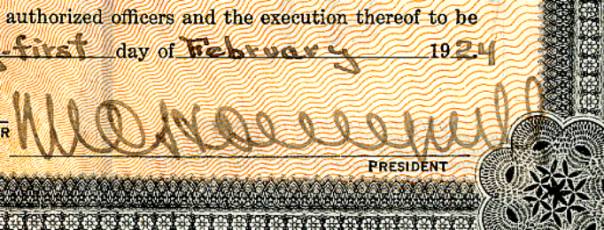
Mark C. Honeywell's Signature on Certificate 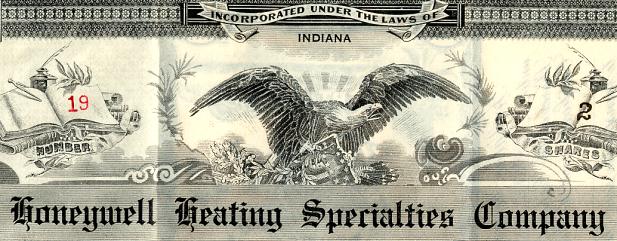
Certificate Vignette Mark Charles Honeywell (December 29, 1874 September 1964) was a U.S. electronics industrialist. He founded the eponymous Honeywell, Incorporated and was its first president (19271933) and CEO (19271933). Honeywell NYSE: HON is a major American multinational corporation that produces electronic control systems and automation equipment. It is a major supplier of engineering services and avionics for NASA, Boeing and the United States Department of Defense. The company was founded by and named after Mark C. Honeywell, a pioneer in automation technology. Honeywell is traded under the ticker symbol HON on the NYSE with a market capitalization of US$30 billion (2006). The company is part of the Dow Jones Industrial Average Index. Mark C. Honeywell was born in Wabash in 1874. He spent his childhood growing up in Wabash and in Florida. As a young man, he had a myriad of jobs... in the citrus and bicycle business, for example, and in his father's Wabash mill. He graduated from Eastman Business College in Poughkeepssie, New York in 1891. In 1899, he married a Wabash girl, Olive Lutz. Mr. Honeywell developed a hot water heating system. In 1905 he installed, in his house located close to the Honeywell Center, what was thought to be the first such system in America. The idea of hot water heating came from England. Radiators first came from there and molds were made from them in Wabash. His business, M.C. Honeywell Heating and Sanitary Work, became Honeywell Heating Specialties Company. By 1906 the company was making thermostats and automatic controls for heating systems. By 1927, company sales were more than $1.5 million and 450 people worked in the Wabash factory. Mr. Honeywell's competitor was W.R. Sweatt and his Minneapolis Heat Regulator Company. The two companies had patents which blocked each other from further growth. They merged to form Minneapolis Honeywell Regulator Company with Mr. Sweatt as Chairman and Mr. Honeywell as President. Today, Honeywell Inc. is a multi-national company with over 100,000 employees. History: 1924: Mark C. Honeywell, a pioneer in automation technology, develops clock-controlled thermostats in his company: "Honeywell Heating Specialties Company". 1927: William R. Sweatt, proprietor of the "Minneapolis Heat Regulator Company" and Mark C. Honeywell, proprietor of the "Honeywell Heating Specialties Company" in Wabash, Indiana, merge their two companies together. The new firm operating under the name of the "Minneapolis-Honeywell Regulator Company" is established as a joint stock corporation and achieves a sales of $5.25 million as early as 1928. 1934: The product range for industrial applications is substantially increased by the acquisition of the "Brown Instruments Company" at the end of 1934. Established in Philadelphia in 1859, the company produced display and writing control units for industrial processes. The Brown Instruments Company also operated internationally. 1942: As a result of the requirements which were placed on the company during the preparation for America's participation in the Second World War, the aero division developed as the basis for the present Aerospace business. 1945: Company sales break through the 100 million Dollar barrier for the first time. More than 17,000 employees were working for the company worldwide. 1950s: Honeywell opens additional branches and production units across the globe. Honeywell reacts to the increasing demand for automation technology with innovative developments. 1953: Perhaps the best-known control unit in the world, the Honeywell-Thermostat T68 "The Round®", replaces the previous bulky rectangular regulator in the domestic sector. "The Round" is now just as well known in the USA as Coca-Cola or McDonalds. It is still being produced today. 1960s: Honeywell enters other automation technology sectors (industrial automation, sensors, aviation and space travel). In 1967, Honeywell's sales break through the 1 billion dollar barrier for the first time. Honeywell performs leading development work in the building control technology sector. 1972: WSE (now NexWatch, a Honeywell-Company) invents the contactless access control system. 1980s: Worldwide alliances are entered into to strengthen the company. The establishment of joint ventures in the West and East increase Honeywell's international outlook and the scope of its activities. The armature factory Heinrich Braukmann is acquired in Germany in 1980 and renamed Honeywell Braukmann GmbH. The acquisition of Central Bürkle GmbH in the heating control sector follows in 1984. 1990s: In March 1997, Honeywell Inc. concludes the acquisition of shares in Measurex Corp. (Cupertino, California). The merger of Honeywell and AlliedSignal takes place in 1999. AlliedSignal has its roots in the company Allied Chemical & Dye Corporation, which was as an amalgamation of five American chemical companies established in the 1800s. Because Germany had controlled much of the world´s chemical market during World War I, Washington Post publisher Eugene Meyer and scientist William Nichols formed this new company in 1020. 1928: Allied opened a synthetic ammonia plant near Hopewell, Virginia, becoming the world's leading producer of ammonia. This was the company's earliest venture into new markets. After World War II, Allied began manufacturing other new products, including nylon 6 (for making everything from tires to clothes) and refrigerants. In 1958, it became Allied Chemical Corp. and moved into its current corporate headquarters in Morristown, New Jersey. 1962: Allied bought Union Texas Natural Gas, which owned oil and gas properties throughout the Americas. Allied regarded it mainly as a supplier of raw materials for its chemical products, but this changed in the early 1970s when CEO John Connor (secretary of commerce under Lyndon Johnson) sold many of Allied's unprofitable businesses and invested in oil and gas exploration. By 1979, when Edward Hennessy Jr. became CEO, Union Texas produced 80% of Allied's income. Under its new name, Allied Corp. (1981), the company went on to purchase the Bendix Corp., an aerospace and automotive company, in 1983. By 1984, Bendix generated 50% of Allied's income, while oil and gas generated 38%. 1985: Allied merged with the Signal Companies, adding critical mass to its aerospace, automotive and engineered materials businesses. Founded by Sam Mosher in 1922 as the Signal Gasoline Company, Signal was originally a California company that produced gasoline from natural gas. In 1928, the company changed its name to Signal Oil & Gas, entering into oil production the same year. Signal merged with the Garrett Corporation, a Los Angeles-based aerospace company, and in 1968: the company adopted the Signal Companies as its corporate name. The addition of Signal's Garrett division to Bendix made aerospace Allied-Signal's largest business sector. In 1985, the company sold 50% of Union Texas, and in 1986 it divested 35 non-strategic businesses through the formation and spin-off of The Henley Group, Inc. In mid-1991: With a new CEO, Lawrence A. Bossidy, and new leadership in many key businesses, Allied-Signal began a comprehensive program of transformation. Bold actions were taken to improve cash flow and operating margins, to increase productivity, and to position the company as a global competitive force for the years ahead. The Allied-Signal name was changed to AlliedSignal in 1993 to reinforce a one-company image and signify the full integration of all of its businesses. 1992: the company sold its remaining interest in Union Texas through a public offering for $940 million in net proceeds. Throughout the 90's, Lawrence A. Bossidy led a growth and productivity transformation that quintupled the market value of AlliedSignal shares and significantly outperformed the Dow Jones Industrial Average and the S&P 500. Honeywell was founded and shaped by inventive technical people and superior leadership. These same values power the new Honeywell. The new Honeywell captures the best of its AlliedSignal and Honeywell Inc. heritage, and is one of the world's leading companies. Southern Africa Since its introduction into the South African industry in the early sixties via the R.H. Harris franchise, Honeywell has played a major role in the development of the resources of South Africa. Honeywell (Pty) Limited was established in South Africa in 1969, initially dealing with automation and control components, but subsequently becoming a major supplier to the process control industry especially in the unique oil-from-coal industry. In 1986 the business interests of Honeywell (Pty) Limited were sold to a South African company, Murray and Roberts and Martech Controls was formed. On 20 December 1993 the Martech Control Business was re-acquired by Honeywell. A wholly owned subsidiary, Honeywell Southern Africa was established with responsibility for the marketing and support of all Honeywell process control systems and products in sub-Saharan Africa
Honeywell NYSE: HON is a major American multinational corporation that produces electronic control systems and automation equipment. It is a major supplier of engineering services and avionics for NASA, Boeing and the United States Department of Defense. The company is headquartered in Morristown, New Jersey. Honeywell was one of the eight major computer companies (with IBM - the largest, Burroughs, Scientific Data Systems, Control Data Corporation, General Electric, RCA and UNIVAC) through most of the 1960s. In 1970, Honeywell bought General Electric's computer division; in 1991 Honeywell's computer division was sold to Groupe Bull. The current corporation is the product of a merger between AlliedSignal and Honeywell Inc. in 1999. The company chose to keep the name "Honeywell International Inc.," but moved its headquarters from Minneapolis, Minnesota to New Jersey. Honeywell is a Fortune 50 company with a workforce of over 100,000. Honeywell has many brands that consumers may recognize. Perhaps the most recognizable product is its line of home thermostats, particulary the famous round variety. History from Wikipedia and OldCompanyResearch.com.

Mark C. Honeywell's Signature on Certificate

Certificate Vignette
Honeywell NYSE: HON is a major American multinational corporation that produces electronic control systems and automation equipment. It is a major supplier of engineering services and avionics for NASA, Boeing and the United States Department of Defense. The company is headquartered in Morristown, New Jersey. Honeywell was one of the eight major computer companies (with IBM - the largest, Burroughs, Scientific Data Systems, Control Data Corporation, General Electric, RCA and UNIVAC) through most of the 1960s. In 1970, Honeywell bought General Electric's computer division; in 1991 Honeywell's computer division was sold to Groupe Bull. The current corporation is the product of a merger between AlliedSignal and Honeywell Inc. in 1999. The company chose to keep the name "Honeywell International Inc.," but moved its headquarters from Minneapolis, Minnesota to New Jersey. Honeywell is a Fortune 50 company with a workforce of over 100,000. Honeywell has many brands that consumers may recognize. Perhaps the most recognizable product is its line of home thermostats, particulary the famous round variety. History from Wikipedia and OldCompanyResearch.com.


